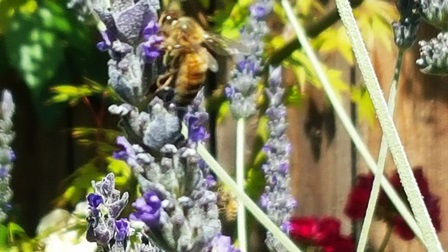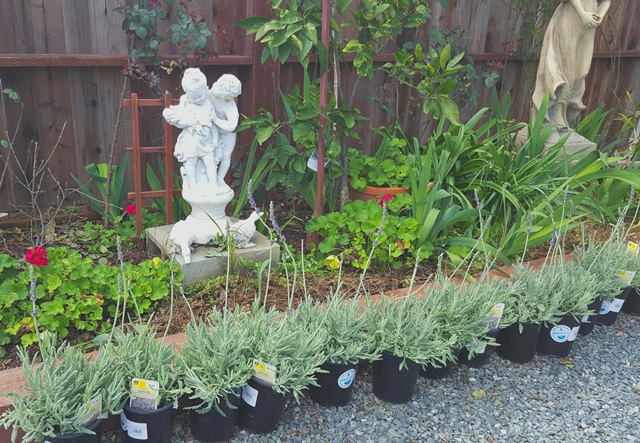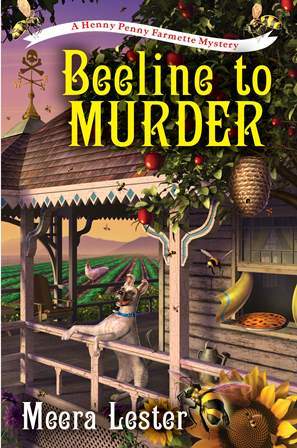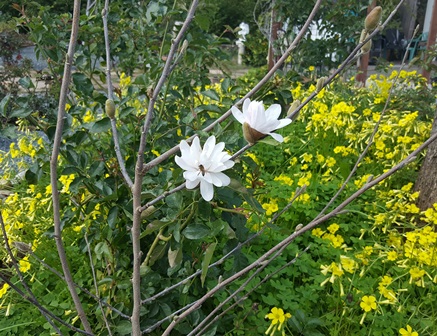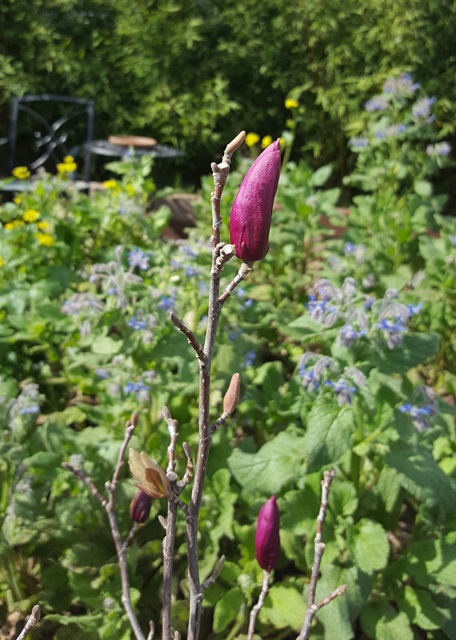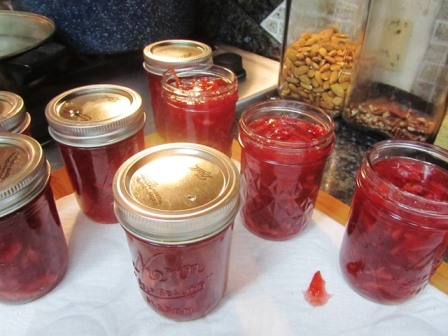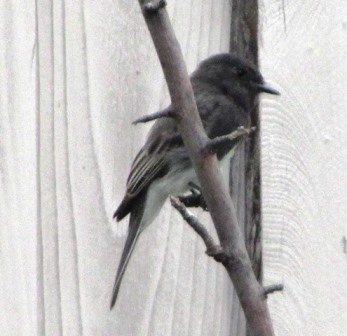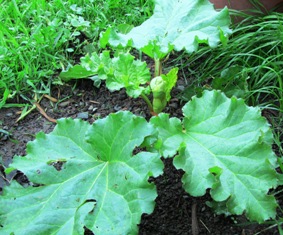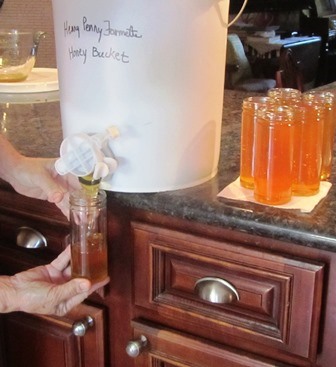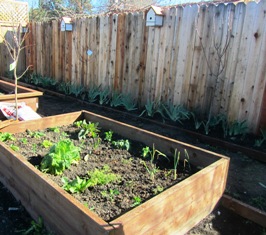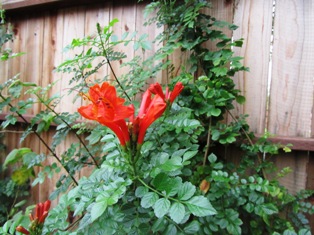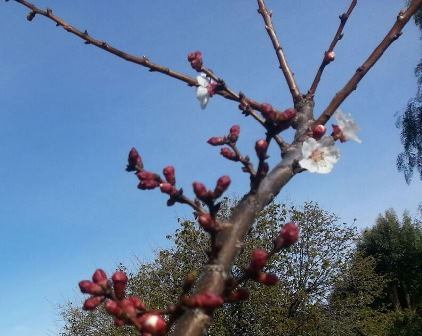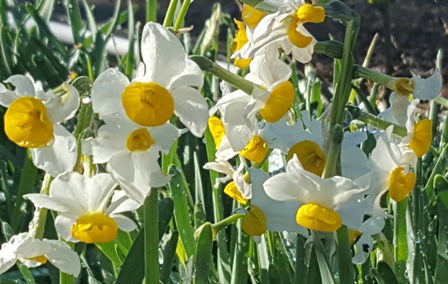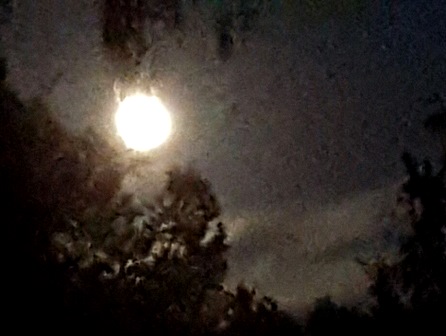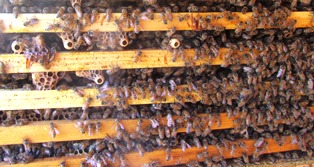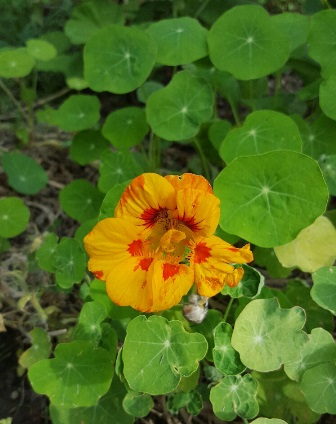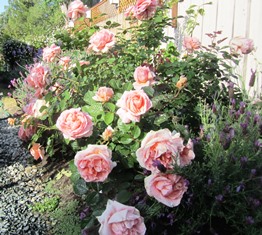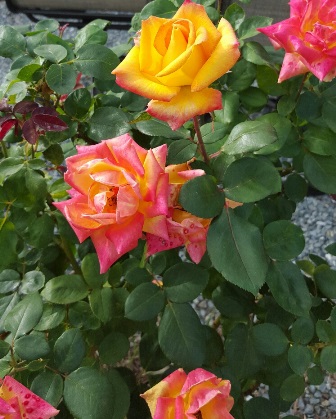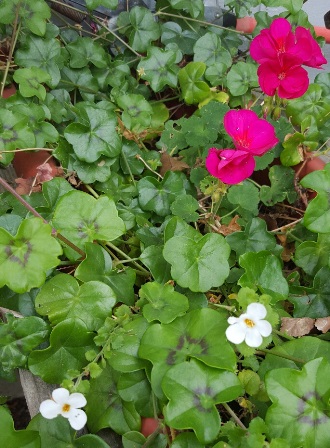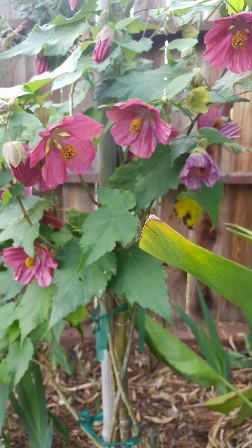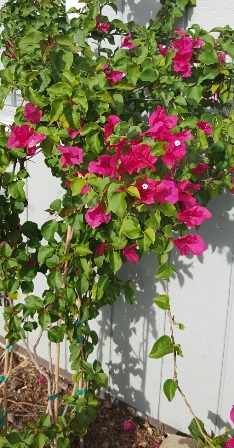Archive for the 'Gardening' Category
French Lavender–A Favorite of Pollinators
It’s bare-root season, a special time of the year for me. I like to visit local nurseries and check out the new offerings of heirloom roses, fruit trees, berries, herbs, and flowers. No matter which nursery I visit, I always seem to spot the lavender first.
After we moved to the Henny Penny Farmette, we put in lots of French lavender. But after a few years, the stalks have grown old and woody.
Recently, on a visit to a nearby nursery, we purchased twenty one-gallon plants of French Lavender, an upright perennial that we’ve discovered blooms almost all year long in our Bay Area climate.
Now, they are hardening off in my garden until I get around to planting them.
The word “dentata” means toothed and a closer examination of the foliage reveals fringed indentations.
This aromatic, shrub has been around for centuries. Valued for its ornamental and medicinal properties, it also is used for soil erosion control. Once established, the lavender is drought tolerant.
Many gardeners love this lavender for its gray-green leaves. When other flowering plants in the garden have finished their blooming cycle, this lavender keeps producing tall spikes of bright purple florets.
Not as brilliant in color as the English or Spanish lavender, the French lavender is lovely grouped together in a single area where its flower stalks can sway in the wind. Our honeybees and other pollinators love it.
* * *
If you are a fan of cozy mysteries and love farmette topics like gardening of heirloom vegetables, herbs, and fruits as well as keeping chickens and bees, check out my Henny Penny Farmette series of cozy mysteries from Kensington Publishing.
Besides a cozy mystery to solve, these books mix in delicious recipes, farming and gardening tips, facts about keeping bees and chickens, and morsels of farm wisdom.
- COMING SOON– Sept. 2017, the third novel in the Henny Penny Farmette series
The Star of Spring–the Mighty Magnolia
My spouse hails from the Caribbean where a variety of magnolias grow, but many in the islands are under threat from deforestation and small distributions. He’s wanted to plant a magnolia tree since we moved to the farmette. Recently, on a rainy evening, we ventured out to our local nursery and purchased a Royal Star and a Jane magnolia for the large entrance area at the front of our property.
Often, it is the m. grandiflora that comes to mind when someone mentions a magnolia tree. It’s a big evergreen tree with glossy leaves, large tulip-shaped white flowers, and dense canopy. This tree blooms summer and fall, while other types of magnolias bloom before their leaves show in the spring.
Magnolias offer gardeners many options–evergreen or deciduous types, wide-range of flower colors, slow or fast-growing trees, and small to large and stately specimens. Named for the French botanist Pierre Magnol (1638-1715), the genus includes about 100 species.
Magnolia blossoms are fragrant and attract various pollinators. While some magnolias grow well in containers for a few years or as espaliers, the larger, showy trees are often planted along city streets and in parks.
Until we have settled on the exact planting site for each of our magnolias, they will remain in their pots. Where to plant them is an important decision since magnolias do not like to be moved once established. As a general rule, they need rich well-drained soil and benefit when the soil has plenty of organic matter like leaf mold, peat moss, and ground bark mixed in at planting time.
Magnolia trees must be planted no lower than their original soil level (where the trunk begins in the planting pot). Because they need plenty of water until established, it’s a good idea to dig a watering basin around them. Young trees must be staked to protect against wind damage.
We chose the Royal Star magnolia (magnolia stellata) because it can hold abundant and spectacular white (or pink) perfumed blossoms throughout spring into summer. Reaching a height of 15 feet with a canopy spread to 10 feet, this beauty looks magnificent against a garden fence. Such a barrier will help protect it against the wind and also create a foil for the blossoms. Come autumn, songbirds will feast on the high-fat content of the star magnolia’s capsules of orange seeds.
The Jane magnolia is one in a Little Girl series of hybrid magnolias that include: Ann, Betty, Judy, Pinkie, Randy, Ricki, and Susan. These magnolias were developed in the mid-1950s at the National Arboretum by Francis DeVos and William Kosar. Jane has large-cup flowers opening reddish-purple with white interiors. Shortly after the blossoms show, the leaves emerge as a coppery-red before turning green.
At the moment, our Jane magnolia, with its roots balled and wrapped in burlap and looking like a shrubby bush, is covered with an abundance of buds as yet unfurled. The buds hold the promise of the fragrant purple blossoms in a couple of weeks. This slow-growing magnolia will reach a height of 10 feet with a 10-foot canopy spread. The plant will be a sure show-stopper in any Northern California garden, especially in spring.
* * *
If you enjoy reading about gardening or other farm topics like keeping bees and chickens, check out my cozy mysteries–A BEELINE TO MURDER, THE MURDER OF A QUEEN BEE, and (coming Sept. 2017) A HIVE OF HOMICIDES (in the Henny Penny Farmette series from Kensington Publishing).
My farm-based novels feature delicious recipes, farming tips, chicken and beekeeping tips, sayings and, of course, a charming cozy mystery. The books are available through online retailers such as Amazon, Barnes & Noble, Target, BAM, Kobo Books, and Walmart as well as from traditional bookstores everywhere.
See, http://tinyurl.com/hxy3s8q
See, http://tinyurl.com/h4kou4g
See, http://tinyurl.com/zsxqmm3
20 Things to Do on a Farm When It’s Raining
Rain . . . unrelenting rain makes working outside near impossible. Since rain is in the forecast for the rest of this week, I’m doing indoor projects here on the Henny Penny Farmette. Why? Because let’s face it: try driving screws into wet fence boards or digging when the earth is like a giant mud ball, or pruning trees when looking upward against a downpour is rather ridiculous. Here are some things to do inside until the weather clears up.
1. Clean the clutter from the kitchen and test some new recipes
2. Read seed catalogs
3. Order beekeeping supplies (to be ready when the weather turns warm and the bees get active)
4. Make a batch of blood orange marmalade (since blood oranges are ripe now)
5. Feed bees, birds, and other wildlife
6. Work on indoor renovation such as finish the installation of base boards and crown moldings
7. Sew curtains; make a quilt, or start an embroidery or knitting project
8. Start the spring cleaning in one or more indoor rooms
9. Plan the spring vegetable garden on paper with a drawing
10. Clean out closets and recycle unused items from cupboards and drawers
11.Make herbal teas (for example: dried leaves of herbs such as mint, dried lemon or orange peel, spices, rose hips, and dried berries)
12. Catch up on your reading for pleasure or books and periodicals about farm and homesteading topics
13. Bring your beekeeping or gardening journal up to date
14. Order supplies–antibiotics for the chickens or medicines for your bees and other domestic stock
15. Bottle honey from the bucket and affix labels
16. Make a dazzling dessert
17. Mend clothing
18. Start working on the taxes for the upcoming season
19. Play your fiddle, piano, horn, or drum
20. Start heirloom seed in flats or get some sprouts growing in a jar
* * *
If you enjoy reading about farming topics, check out my cozy mystery series from Kensington: A Beeline to Murder, The Murder of a Queen Bee, and A Hive of Homicides. Delicious recipes, farm lore, and tips for keeping chickens and bees add to the charm of these delightful mysteries.

- COMING September 2017
- These books are available through online retailers and traditional bookstores everywhere.
See, http://tinyurl.com/hxy3s8q
A Beeline to Murder is the debut novel that launched the Henny Penny Farmette series of mysteries.
See, http://tinyurl.com/h4kou4g
The second cozy mystery in the Henny Penny Farmette series is garnering great reviews from readers and industry publications.
How to Attract Hummingbirds to Your Garden
Here on the Henny Penny Farmette, we love watching the spectacular aerial maneuvers of male hummingbirds attempting to attract the interest of a nearby female. These gorgeous feathered flirts know how to bedazzle a potential mate with spectacular maneuvers that show off the intense coloring of their iridescent feathers.
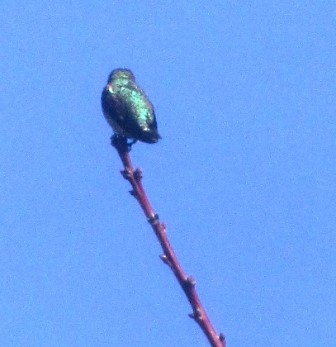
A hummer’s iridescent feathers shimmer as it perches in sunlight at the end of an apricot tree branch
Depending on the species, these tiny birds can flutter their wings in a figure eight pattern (they don’t flap them) from 12 to 80 times per second. All that fluttering requires tremendous energy.

Hummers are attracted by the intense hue of certain flowers such as nasturtiums and the promise of nectar
Hummers mainly get their energy from plants with brightly colored, nectar-rich flowers. They will dine at hummingbird feeders filled with red sugar-water and hung around gardens that feature plants with brightly colored blooms, especially if those blooms are high in nectar. The following is a list of plants known to attract hummingbirds.
- Impatien
- Nasturtium
- Phlox
- Nicotiana (flowering tobacco)
- Salvia (scarlet sage)
- Snapdragon
If you like plants that return each year, tuck in these brightly colored perennials.
Alcea rosea
- Aloe
- Bee Balm
- Columbine
- Coral Bell
- Four-o-clock
- Gladiola
- Penstemon
- Phlox
- Salvia
Shrubs such as the butterfly bush (Buddleia) and the flowering maple, hibiscus, and rosemary hold a special appeal for the hummers. They also will be attracted to blooming vines (especially those with trumpet or tube-shaped flowers in intense colors). Tuck in Cape honeysuckle, flame vine, or the blood-red trumpet creeper and watch the hummers darting in and around these vines from dawn until dusk. For more ideas, visit your local nursery or birding store.
* * *
Do you enjoy reading about farming topics? Check out my cozy mysteries–A BEELINE TO MURDER and also THE MURDER OF A QUEEN BEE (both in the Henny Penny Farmette series from Kensington Publishing).
My farm-based novels feature delicious recipes, farming tips, chicken and beekeeping tips, sayings and, of course, a charming cozy mystery. For more info, click on the links under the pictures.
The books are available through online retailers such as Amazon, Barnes & Noble, Target, BAM, Kobo Books, and Walmart as well as from traditional bookstores everywhere.
See, http://tinyurl.com/hxy3s8q
A Beeline to Murder is the debut novel that launched the Henny Penny Farmette series of mysteries. Initially released as a hardcover novel and in e-book format, it is now available as a mass market paperback.
See, http://tinyurl.com/h4kou4g
NEWLY RELEASED! This, the second cozy mystery in the Henny Penny Farmette series, is garnering great reviews from readers and industry publications.
Flowering Cherry Trees Create Drama in a Landscape
We just planted a couple of flowering cherries as a dramatic focal point for our front entrance area. Reaching a height of 30 to 40 feet, these ornamental trees require little beyond full sun and well-drained soil. If drama is desired in a landscape, these trees won’t disappoint.
Although California’s extreme five-year-drought has been declared over here in the Bay Area, a front lawn seemed to us unnecessary. Instead, we’re spreading small pebble gravel in a landscape that includes statuary, garden furniture and potted plants. We have a natural stone curved path lined with roses that leads from the driveway to house and raised beds of flowers, roses, and bird-of-paradise plants along with a few small trees–lilac, smoke, and citrus.
The flowering Japanese Yoshino cherry trees will provide palest pink blossoms with a light almond scent in the spring and shade in the summer. The trees are fast growing–exactly what we need to replace the massive (and yet fragile) elm tree that came down this past year. It stood next to the house and provided cool shade over the front porch until it split and fell.
Bare root season is a good time to purchase flowering cherries and other ornamental and fruit trees. The bare-root trees are also less expensive, but no less viable when planted according to instructions on the packaging around their roots. If you like drama in your landscape, consider these hardy, drought-resistant trees.
* * *
If you have enjoyed reading about this farming/gardening topic, check out my cozy mysteries–A BEELINE TO MURDER and also THE MURDER OF A QUEEN BEE (both in the Henny Penny Farmette series from Kensington Publishing).
My farmette and bee-based novels are chocked full of recipes, farming tips, chicken and beekeeping tips, sayings and, of course, a charming cozy mystery. For more info, click on the links under the pictures.
The books are available through online retailers such as Amazon, Barnes & Noble, Target, BAM, Kobo Books, and Walmart as well as from traditional bookstores everywhere.
See, http://tinyurl.com/hxy3s8q
A Beeline to Murder is the debut novel that launched the Henny Penny Farmette series of mysteries. Initially released as a hardcover novel and in e-book format, it is now available as a mass market paperback.
See, http://tinyurl.com/h4kou4g
NEWLY RELEASED! This, the second cozy mystery in the Henny Penny Farmette series, is garnering great reviews from readers and industry publications.
Critter-proofing Your Bulbs
I planted bagfuls of tulips, daffodils, crocus, and grape hyacinths over the last two years in the autumn. The daffodils are blooming now and the other bulbs in my garden have plenty of foliage.
Because voles, moles, gophers, squirrels, raccoons, and other critters will dig and eat the bulbs and deer will devour the blooms at first blush of color, a savvy gardener must figure out how to protect these beautiful flowers.

The bees are drawn to the sweet scent of narcissus that have now naturalized in my Henny Penny Farmette gardens
Throughout the Midwest of my youth, hillsides, front yards, and cemeteries were always places where daffodils grew in perfusion. Along with the arrival of robins and other songbirds, these flowering bulbs herald the coming light and warmth of spring. I’ve lost plenty of these plantings myself so have some tips to help you prevent such a loss.
Seven ways to protect flowering bulbs.
1. Grow them behind a double fence barrier. Deer can jump high and might go over one fence, but not a second one built near the first.
2. Use mesh to deter moles, voles, gophers, groundhogs, and other digging critters.
3. Erect fences that are at least three feet tall and with at least a foot buried beneath the earth.
4. Plant in raised beds covered with mesh. The bulbs will be protected while the foliage and blooms poke through toward the light.
5. Clean up the area in the fall after planting the bulbs. That way, critters won’t be attracted to your bulb beds.
6. Consider using deer-repellent sprays on tulips and growing deer-resistant bulbs.
7. Use ammonia-soaked rags in coffee cans or old planting buckets around the garden to repel pests with a keen sense of smell such as rabbits and opossums.
* * *
Enjoy reading about farming topics? Check out my cozy mysteries–A BEELINE TO MURDER and also THE MURDER OF A QUEEN BEE (both in the Henny Penny Farmette series from Kensington Publishing). Kobo Books has A BEELINE TO MURDER on sale. Check out this incredible deal on https://www.kobo.com/us/en/search?Query=Meera+Lester
My farmette and bee-based novels are chocked full of recipes, farming tips, chicken and beekeeping tips, sayings and, of course, a charming cozy mystery. For more info, click on the links under the pictures.
The books are available through online retailers such as Amazon, Barnes & Noble, Target, BAM, Kobo Books, and Walmart as well as from traditional bookstores everywhere.
See, http://tinyurl.com/hxy3s8q
A Beeline to Murder is the debut novel that launched the Henny Penny Farmette series of mysteries. Initially released as a hardcover novel and in e-book format, it is now available as a mass market paperback.
See, http://tinyurl.com/h4kou4g
NEWLY RELEASED! This, the second cozy mystery in the Henny Penny Farmette series, is garnering great reviews from readers and industry publications.
Winter Solstice Day
It’s that time of the year when we mark the shortest day of the year, the beginning of winter, and the return of the light. I like to think of it as a day when I decide what I do and don’t want to take with me into the coming New Year.
We’ve had a run of cold nights with temperatures in the upper 20 degrees Fahrenheit. But the light will soon return and warm the Earth. Late January-early February marks the beginning of bare-root season. My work now includes pruning and spraying and clearing out the old to make way for rebirth and renewal.
Among the plants that renew are the fruit trees. The pruned branches, garden clippings, and old vines are being recycled into compost for next spring’s garden. Come late spring, I’ll have trees with gorgeous canopies and tons of fruit to make into jam.
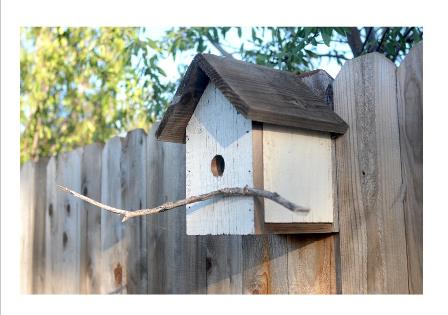
This DIY birdhouse is crafted from a repurposed fence board. Not all birds will take up residence in a house, but many will.
Garlic and onions are growing now and will through the winter months, thanks to our mild Mediterranean climate. But there is so much cleanup of the property that needs doing, I can only hope to start that today.
I’m putting out seed balls for the birds as well as refilling feeders and suet holders. Easy-to-find food keeps our feathered songsters around through spring when they start their families. For directions on making a birdhouse for your garden, check out https://hobbyreads.wordpress.com/category/crafts.
*******************************************************************************************************************************************************
Enjoy reading about farming topics? Check out my cozy mysteries–A BEELINE TO MURDER and also THE MURDER OF A QUEEN BEE (both in the Henny Penny Farmette series from Kensington Publishing).
JOIN THE CHRISTMAS EVE FUN–Read a short excerpt from my newest book, THE MURDER OF A QUEEN BEE and check out blogger Brooke Bumgardner’s interview of me at http://www.brookeblogs.com
My farmette and bee-based novels are chocked full of recipes, farming tips, chicken and beekeeping tips, sayings and, of course, a charming cozy mystery. For more info, click on the links under the pictures.
The books are available through online retailers such as Amazon, Barnes & Noble, Target, BAM, Kobo Books, and Walmart as well as from traditional bookstores everywhere.
See, http://tinyurl.com/hxy3s8q
This debut novel launched the Henny Penny Farmette series of mysteries and sold out its first press run. It’s now available in mass market paperback and other formats.
See, http://tinyurl.com/h4kou4g
NEWLY RELEASED! This, the second cozy mystery in the Henny Penny Farmette series, is garnering great reviews from readers and industry publications. Get your copy while you can. It’s sure to sell out like novel #1.
Cold Weather Means Protecting Citrus, Covering Hives
It’s hard to believe Thanksgiving is next week and already, the first snows have arrived in the Sierras and Rockies.

The water in our Italian fountain froze overnight and now the birds and bees that drink there must wait for the sun to melt the ice.
The plunge of nighttime temperatures here on the Henny Penny Farmette are hovering at frost and freezing levels. This morning, I walked with a steaming cup of coffee and noticed the thermometer hovering at 39 degrees Fahrenheit. That means our citrus trees and other frost-intolerant plants must be protected or moved indoors.
The work I’ve been bearing down on–a new book, mystery promo, and prep for Thanksgiving–now have to be put aside for a few hours. I’ve got plenty of cold-weather work to do outside.
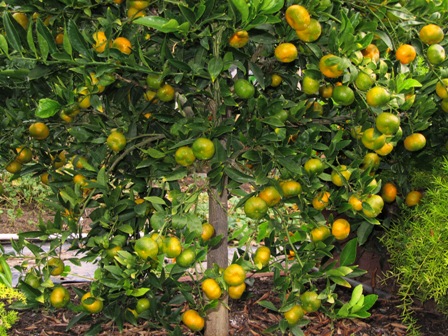
Our Satsuma mandarin orange tree prolifically bears fruit this time of year but is susceptible to freeze
Citrus trees will be covered with blankets against the frost. I’m hanging the heat lamp in my chicken house. I need to clean the chicken house, put more straw in the nesting boxes, and a ground corncob material on the floor. Already, I’ve put the windows back in (leaving a crack open for ventilation).
I opened the beehives last weekend and added an extension onto one hive–something not normally done during autumn when you typically shrink the size of your hives. The hive seemed overpopulated and the bees seemed stressed. After closing that hive, I wrapped both of them with blankets.
With the the citrus protected, the heat lamp in the chicken house, and the beehives covered, I can return to my indoor work . . . it never stops but my passion has always been to live close to the earth and write. This is the good life, made better by this wonderful Mediterranean-like climate that enable our citrus and grapes to thrive (although plunging temps make for a little extra work protecting them).
* * *
Enjoy reading about farming topics? Check out my cozy mysteries–A BEELINE TO MURDER and also THE MURDER OF A QUEEN BEE (both in the Henny Penny Farmette series from Kensington Publishing).
These novels are chocked full of recipes, farming tips, chicken and beekeeping tips, sayings and, of course, a charming cozy mystery. For more info, click on the links under the pictures.
The books are available through online retailers such as Amazon, Barnes & Noble, Kobo Books, and Walmart as well as from traditional bookstores everywhere.
See, http://tinyurl.com/hxy3s8q
This debut novel launched the Henny Penny Farmette series of mysteries and sold out its first press run. It’s now available in mass market paperback and other formats.
See, http://tinyurl.com/h4kou4g
NEWLY RELEASED! This, the second cozy mystery in the Henny Penny Farmette series, is garnering great reviews from readers and industry publications.
Seasonal Blooms for Floral Arrangements
Autumn in Northern California is one of my favorite times of the year. By November, many of the summer blooms in our flower beds have faded. Seeds have been collected for next year’s blooms. Now’s the time to put in bulbs and tubers for spring, but that doesn’t mean we have no blooms for a Thanksgiving floral arrangement.
The clocks have been turned back and the rainy season has arrived, but don’t tell that to the roses.
Red-gold roses, pyracantha berries, rustic seed pods, orange- and rust-colored zinnias, asters, willowleaf cotoneaster, and dahlias are some of the garden plants that combine beautifully in a fall floral arrangement. To the harvest table, I also like to add some seasonal fruits like pomegranates and persimmons.
Thanks to the recent rain, the bougainvillea blazes in shades of fuchsia, orange, red, and purple. Zinnia’s near the farmette’s bee house are still holding color and hanging on until cold weather arrives.
And while pyracantha (fire thorn) berries add splashes of bright orange to a dark corner of the garden where bamboo towers to ten feet, the Chinese lantern plant holds aloft dozens of small pink blooms like little lanterns.
With Thanksgiving three weeks away, I’m feeling confident that our table arrangement will include some of the season’s festive berries, seed pods, and blooming flowers collected from around the farmette.
In the meantime, I’ll notice the splashes of color to be discovered here and there and consider how to use them in a holiday bouquet.
* * *
NEWLY RELEASED–The Murder of a Queen Bee (Kensington Publishing, NY–Sept. 2016).
Discover delicious farm-to-table recipes, farming tips, and wisdom as well as sort out a charming whodunnit. Also, enjoy gardening tips and farm sayings. Dig for clues while learning about bees and chickens. To learn more, click on the link under the picture.
See, http://tinyurl.com/h4kou4g
See, http://tinyurl.com/hxy3s8q
This debut novel launched the Henny Penny Farmette series of mysteries and sold out its first press run. It’s now available in mass market paperback and other formats.
Happy birthday/release day to THE MURDER OF A QUEEN BEE
Today’s blog will be a short one–I’m tracking down the foxes that showed up on my front porch after snagging a chicken from my neighbor’s hen house. The foxes stood on my front porch late last night. My hubby saw them and thought they were cats. He checked on our chickens to make sure they were safe and called me.
I am house-sitting and pet-sitting for a relative who lives a mile away. This means I am running back and forth between the two properties, while trying to blog, do farming chores, and clean.
But today is special because it is the official release day for THE MURDER OF A QUEEN BEE, the second cozy mystery in my Henny Penny Farmette series. So I’m taking an extra hour or two here and there to blog and post publicity.
I’m thrilled that already the book is garnering praise from industry publications like Kirkus Reviews, Publisher’s Weekly, and Booklist. Additionally, it is creating buzz in the cozy mystery and new fiction blogosphere.
Goodreads has a giveaway for three autographed, hardbound copies of THE MURDER OF A QUEEN BEE. The giveaway drawing runs from midnight September 29 through midnight August 6. See more at https://www.goodreads.com/book/show/28439447-the-murder-of-a-queen-bee
Happy birthday/release day to my second novel, and good luck everyone entering the drawing. I hope you like ex-cop turned farmette owner Abigail Mackenzie’s newest adventure involving the murder of her herbalist friend Fiona and Fiona’s links to a New Age cult.
 Facebook
Facebook Goodreads
Goodreads LinkedIn
LinkedIn Meera Lester
Meera Lester Twitter
Twitter





